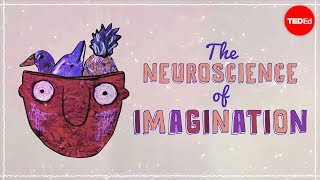(单词翻译:单击)
Imagine, for a second, a duck teaching a French class,
请想象一下,一只鸭子教法语课、
a ping-pong match in orbit around a black hole, a dolphin balancing a pineapple.
在环绕黑洞的轨道上举行的一场乒乓球竞赛、平衡菠萝的一只海豚。
You probably haven't actually seen any of these things, but you could imagine them instantly.
也许你从没有见过以上任何画面,但是你能立马想象出来。
How does your brain produce an image of something you've never seen?
你的大脑如何产生一个你从没见过的画面呢?
That may not seem hard, but that's only because we're so used to doing it.
这个过程也许看起来并不困难,那只是因为我们习惯了“想象”这一过程。
It turns out that this is actually a complex problem that requires sophisticated coordination inside your brain.
实际上,这个过程很复杂,它需要大脑内复杂的配合。
That's because to create these new, weird images,
为了“创造”这些新奇诡异的图片,
your brain takes familiar pieces and assembles them in new ways, like a collage made from fragments of photos.
你的大脑需要取出相近的片段,并重新组合,就像用部分图片做成拼贴画一样。
The brain has to juggle a sea of thousands of electrical signals getting them all to their destination at precisely the right time.
大脑需要发送上千的电信号,将它们在准确的时间内传送到目的地。
When you look at an object, thousands of neurons in your posterior cortex fire.
当你看到一个物体,后额皮质内上千的神经元会受到刺激。
These neurons encode various characteristics of the object: spiky, fruit, brown, green, and yellow.
这些神经能将物体的特点编码:带刺,水果,棕色,绿色,黄色。
This synchronous firing strengthens the connections between that set of neurons,
这一同步的刺激会加强那一组神经元中的联系,
linking them together into what's known as a neuronal ensemble, in this case the one for pineapple.
将神经元连起来,成为神经元集群,也就是,“菠萝”的神经元集群。
In neuroscience, this is called the Hebbian principle, neurons that fire together wire together.
在神经系统科学中,这便是“赫布理论”--同时被刺激的神经元会连接在一起。
If you try to imagine a pineapple later, the whole ensemble will light up, assembling a complete mental image.
当你过一会想象“菠萝”时,这一神经元集群便会“亮起”,在大脑中组合成一完整的图片。
Dolphins are encoded by a different neuronal ensemble.
“海豚”的想象会是另一组神经元集群。
In fact, every object that you've seen is encoded by a neuronal ensemble associated with it,
事实上,你见过的每一物体,都会有一专门的神经元集群为其编码,
the neurons wired together by that synchronized firing.
它们由同时被刺激的神经元组合而成。
But this principle doesn't explain the infinite number of objects that we can conjure up in our imaginations without ever seeing them.
但这一理论并不能解释很多我们没见过也能想象出来的场景。
The neuronal ensemble for a dolphin balancing a pineapple doesn't exist.
为“平衡菠萝的海豚”编码的这一神经元集群并不存在。
So how come you can imagine it anyway?
那是怎么想象出来的呢?
One hypothesis, called the Mental Synthesis Theory, says that, again, timing is key.
一个假设,叫做“心理合成理论”,强调了(神经元被刺激)时间的重要性。

If the neuronal ensembles for the dolphin and pineapple are activated at the same time,
如果为“海豚”和“菠萝”解码的神经元集群同时被刺激,
we can perceive the two separate objects as a single image.
我们就能在一个画面中感知到两个不同物体。
But something in your brain has to coordinate that firing.
但是大脑中必须有东西来协调这一“刺激”。
One plausible candidate is the prefrontal cortex, which is involved in all complex cognitive functions.
一个可能的角色,是前额皮质,它参与了所有“认知”方面的工作。
Prefrontal cortex neurons are connected to the posterior cortex by long, spindly cell extensions called neural fibers.
前额皮质、后额皮质的神经元是连接在一起的,其连接物是细长的细胞延伸物--“神经纤维”。
The mental synthesis theory proposes that like a puppeteer pulling the strings,
这一理论认为:像操纵木偶的人一样,
the prefrontal cortex neurons send electrical signals down these neural fibers to multiple ensembles in the posterior cortex.
前额皮质的神经元发送电信号沿着“神经纤维”,到达后额皮质。
This activates them in unison.
这能同时刺激所需的神经元集群。
If the neuronal ensembles are turned on at the same time,
如果多组神经元集群同时被“刺激”,
you experience the composite image just as if you'd actually seen it.
你就能够体验到如同亲眼见过的“合成”场景了。
This conscious purposeful synchronization of different neuronal ensembles by the prefrontal cortex is called mental synthesis.
前额皮质所实施的这一带有目的性、能够“刺激”多组神经元集群的同步,叫做“心理合成”。
In order for mental sythesis to work, signals would have to arrive at both neuronal ensembles at the same time.
为了能够同步,电信号需要同时到达两种神经元集群。
The problem is that some neurons are much farther away from the prefrontal cortex than others.
但问题是,有的神经元集群距离前额皮质比其他的集群更远。
If the signals travel down both fibers at the same rate, they'd arrive out of sync.
如果电信号以同一速度通过“神经纤维”,那么就无法同时到达。
You can't change the length of the connections,
你不能改变这一距离,
but your brain, especially as it develops in childhood, does have a way to change the conduction velocity.
但是你的大脑,尤其是小时候发育时,能够改变电信号传输的速度。
Neural fibers are wrapped in a fatty substance called myelin.
“神经纤维”被多脂肪的物质“髓鞘层”包裹。
Myelin is an insulator and speeds up the electrical signals zipping down the nerve fiber.
“髓鞘层”是一种绝缘体,它能够加快电信号通过“神经纤维”的速度。
Some neural fibers have as many as 100 layers of myelin. Others only have a few.
一些神经纤维有100多“髓鞘层”。其它神经纤维只有一些。
And fibers with thicker layers of myelin can conduct signals 100 times faster or more than those with thinner ones.
这些有着较厚“髓鞘层”的神经纤维能够以100倍速传输信号,远超有着较薄“髓鞘层”的神经纤维。
Some scientists now think that this difference in myelination could be the key to uniform conduction time in the brain,
一些科学家认为,“髓鞘层”的区别是这一“同步”的关键,
and consequently, to our mental synthesis ability.
从而也是“心理合成”能力的关键。
A lot of this myelination happens in childhood, so from an early age,
很多“髓鞘层”在小时候生长,所以从小开始,
our vibrant imaginations may have a lot to do with building up brains
活跃的想象力就与大脑的建构有很大关系
whose carefully myelinated connections can craft creative symphonies throughout our lives.
只有拥有“髓鞘层”更好的连结,才能够奏出富有想象力的人生乐章!


